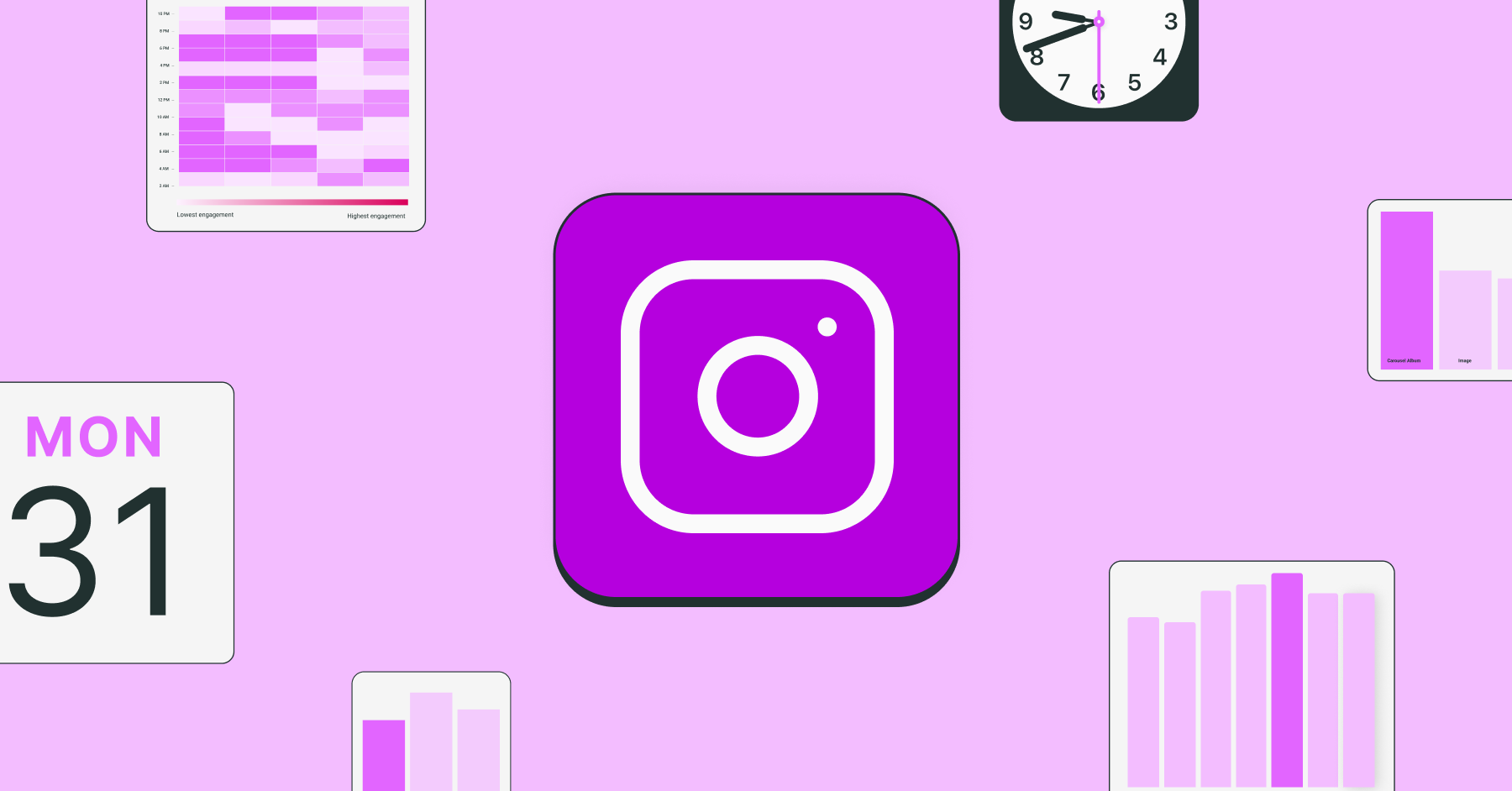
The Best Time to Post on Instagram in 2025: We Analyzed 2 Million+ Posts to Find Out
We analyzed more than 2 million Instagram posts sent through Buffer to pinpoint the best time, day, and post format for maximum reach.

Senior Content Writer @ Buffer
There are many factors to consider when it comes to posting on Instagram — but the one that often feels like a make-or-break decision is what time to post your content.
It's a fair concern — the last thing you want is to spend the time and resources needed to create a showstopper piece of content only to post it in a social media dead zone that results in… crickets.
Sharing Instagram Stories, reels, feed posts, and carousels at optimal times for reach and engagement is an important consideration in your social media strategy. If your content immediately makes it to your target audience's feed while they're around to engage with it, it's more likely to succeed.
That's why we combed through the reach of over 2 million Instagram posts sent through Buffer over the past year: to uncover which days and times are more likely to yield engagement (along with which post formats get the most likes, comments, and shares).
In other words, the best times to post on Instagram, backed by data.
With all that in mind, let's dig into everything you need to know about when you should be posting on Instagram — including how to figure out the best time for your audience, whether you're a marketer, creator, influencer, or casual Instagrammer.
Jump to a section:
- Is there a best time to post on Instagram?
- How we calculated the best times to post on Instagram
- The best times to post on Instagram
- The best time to post on Instagram at a glance
- The best time to post on Instagram each day
- What is the best day of the week to post on Instagram?
- What is the best time to post reels on Instagram?
- The best type of content on Instagram
- How to find the best time to post on Instagram for you
- The best time to post on Instagram FAQs
- Your checklist for high-performing Instagram posts
Is there a best time to post on Instagram?
Let's get this out of the way before we begin: There's no universal best time to post on Instagram for guaranteed success — if only it were that easy.
However, our analysis showed us that there are certain days and times that tend to yield more reach than others. What was really interesting was the patterns we uncovered, too — for example, most weekdays see similar high-reach times.
So, while Instagram timing, or post recency, is not as crucial as it once was (R.I.P. chronological feed), it's still important to consider when developing your social media marketing strategy and determining when to post content.
How we calculated the best times to post on Instagram
It’s tricky to measure the overall success of all Instagram content, given that it all appears in different feeds governed by different algorithms. While engagement on social media posts has been a metric we’ve used in the past, we opted to go with reach in this year’s Instagram analysis instead.
Why did we do that? Isn't it true that the more engagement you receive, the better your post is likely to perform? Well, it depends on your definition of engagement. We felt that on Instagram, in particular, likes, comments, and public shares (the standard hallmarks of engagement) aren’t necessarily the strongest indicator of success anymore, given how highly the algorithm values ‘sends per reach’ — that’s how many users privately share a post or reel with someone via DMs.
Instagram head Adam Mosseri has candidly shared that it is Instagram’s most important algorithmic signal, particularly in the reels and discover feeds.
Plus, if there is a metric you’re aiming for in terms of growing your Instagram following, reach is it. The more users you reach — particularly those who don’t already follow you — the more likely you are to grow your follower base on the platform.
Our methodology here was to look at the median reach of the post in relation to follower count. More followers = more reach, so looking at reach in isolation would also have led to skewed data. Considering reach in relation to follower count was our best bet at providing helpful advice for both growing and well-established brands and accounts.
Phew! Ready to dig into the numbers?
The best times to post on Instagram
The best time to post on Instagram is generally 3 p.m. and 6 p.m. on weekdays.
After analyzing more than 2 million Instagram posts, we found that posts shared at these times tended to get the most reach.
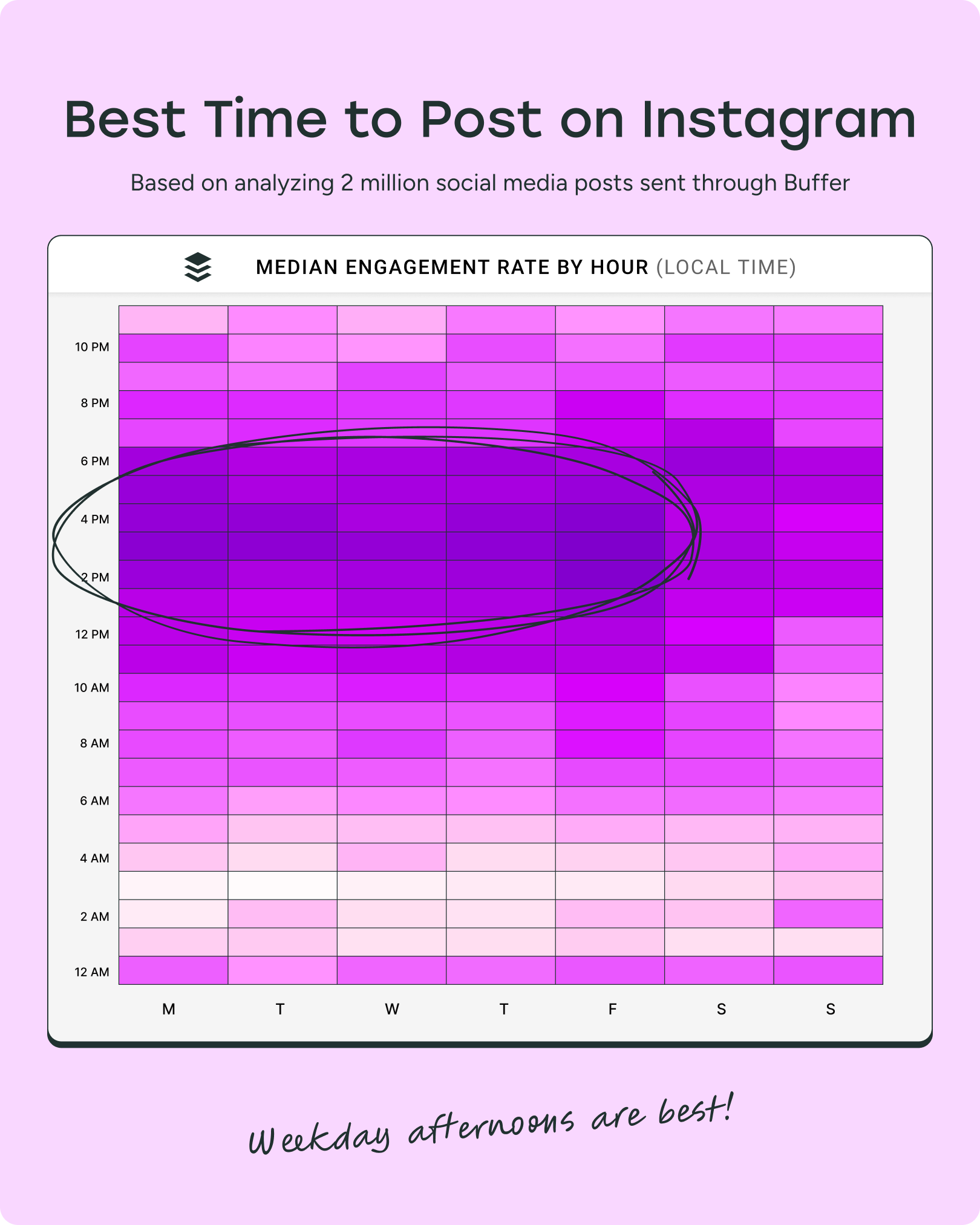
Our theory is that Instagram users, who are largely between the ages of 18 and 34, are likely to spend time on the app in the evenings as they finish up at work. I know I’m definitely more likely to log on as the day wears on and my productivity dwindles or spend time scrolling as I relax in the evening.
According to Statista, 31.7% of 18 to 24-year-olds and 30.6% of 25 to 34-year-olds (i.e. folks with nine-to-five jobs) use the app. In other age groups, use is less than half of that cohort.
Wait — aren’t these people usually still at work at 3 p.m. on weekdays? Indeed they are. But it’s important to note that these graphs show reach, not audience active time. A high reach time at 3 p.m. doesn’t necessarily mean your followers are logging on at exactly 3 p.m. and seeing your post then. Your content will likely percolate for a few hours in various feeds, so posts shared in these slots will likely be shared just in time for the peak evening slots.
As you'll see from the heatmap graph above, Instagram post behavior is pretty predictable, depending on the day of the week. The darkest slots represent the time slots with the highest reach per follower count — indicating the best time to post on Instagram.
The light-colored to white blocks are the time slots with the lowest reach, showing the times that are best avoided.
On weekdays, reach starts to pick up in the early morning at 6 a.m., climbing from 11 a.m. (just in time for their lunch hour!) and peaking at around 3 p.m. on most days.
Weekends are pretty different. Our data shows that reach drops on Saturdays and even more so on Sunday. There are some small peaks in reach in the early evening, but they're lower than the best posting times during the weekdays.
The best time to post on Instagram on weekends is 6 p.m. on Saturday and Sunday.
The best time to post on Instagram at a glance
- Monday: 3 p.m.
- Tuesday: 3 p.m.
- Wednesday: 3 p.m.
- Thursday: 3 p.m.
- Friday: 3 p.m.
- Saturday: 6 p.m.
- Sunday: 6 p.m.
The best time to post on Instagram on Monday
The best time to post on Instagram on Mondays is at 3 p.m., when reach on posts shared tends to be highest. 4 p.m. and 5 p.m. also tend to see higher reach and are great times to schedule posts.
The best time to post on Instagram on Tuesday
The best time to post on Instagram on Tuesday is at 3 p.m. Patterns are similar to reach on Monday, with another (slightly lower) peak at 4 p.m. and 5 p.m.
The best time to post on Instagram on Wednesday
The best time to post on Instagram on Wednesday is also at 3 p.m. Other good times to schedule posts on Instagram are 2 p.m. and 5 p.m.
The best time to post on Instagram on Thursday
The best time to post on Instagram on Thursdays is 3 p.m., very closely followed by 4 p.m. and 2 p.m.
The best time to post on Instagram on Friday
The best times to post on Instagram on Friday are at 3 p.m. 2 p.m. and 4 p.m. are also good posting times.
The best time to post on Instagram on Saturday
The best time to post on Instagram on Saturday is 6 p.m., though it's worth noting that Saturday reach pales in comparison to weekdays. That said, there are some solid options for posting a 3 p.m. and 2 p.m., too.
The best time to post on Instagram on Sunday
The best times to post on Instagram on Sunday are in the evening, from 5 p.m. to 6 p.m. Sunday is also a quiet time on the app, and perhaps not the best day to include in your posting schedule.
This is where social media management tools like Buffer really shine. Experiment by systematically going through the times on the list above, scheduling a post, and tracking its performance to see what works best for your target audience.
💡Interested in learning about the best times on other social media platforms? Here’s the best time to post on TikTok, the best time to post on Facebook, and the best time to post on LinkedIn.
What is the best day of the week to post on Instagram?
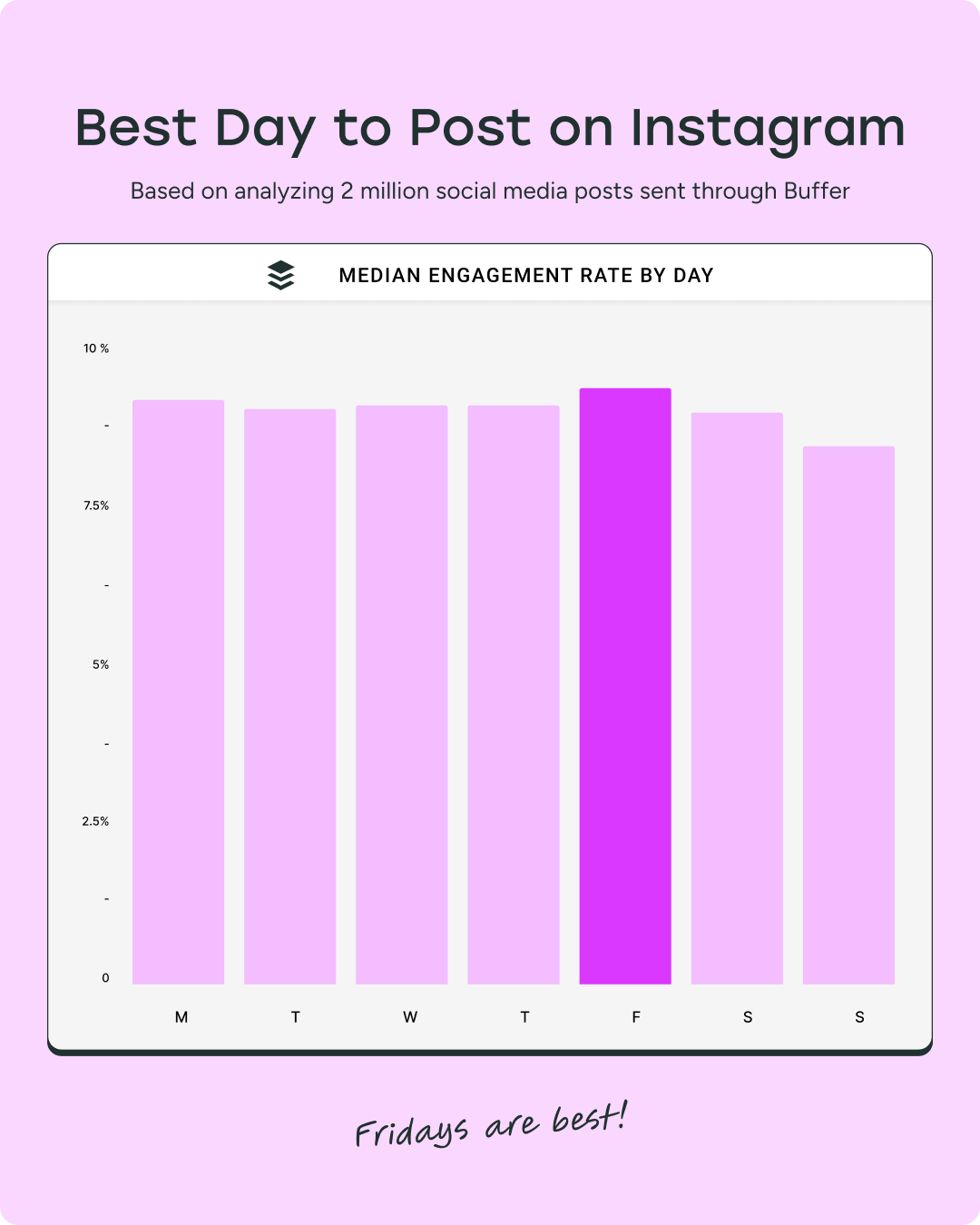
You really can't go wrong with sharing content on Instagram on weekdays. But Monday and Friday are the best days to post on Instagram — an inch about the rest of the week for post performance.
Comparatively, the worst time of the week to post on Instagram is on a Sunday.
What is the best time to post reels on Instagram?
The best time to post reels is between 2 p.m. and 5 p.m. on weekdays, which aligns with all the graphs above. In our analysis, we reviewed all Instagram posts, rather than segmenting by post type.
That said, it's also worth considering that people treat different segments of the Instagram app a little differently.
An update on the algorithm by Head of Instagram Adam Mosseri offers some interesting insight on this front: “People tend to look for their closest friends in stories, use explore to discover new content and creators, and be entertained in reels.”
It stands to reason, then, that people are looking to be entertained at certain times of day, and catch up with friends, family, and their favorite creators at other times.
If you're looking for a slight boost in reels reach, we recommend testing out the peak evening times to post reels. Your followers will have slightly more time to scroll and enjoy your content before bedtime than they would in the peak morning slots when they need to rush off to work.
The best type of content on Instagram
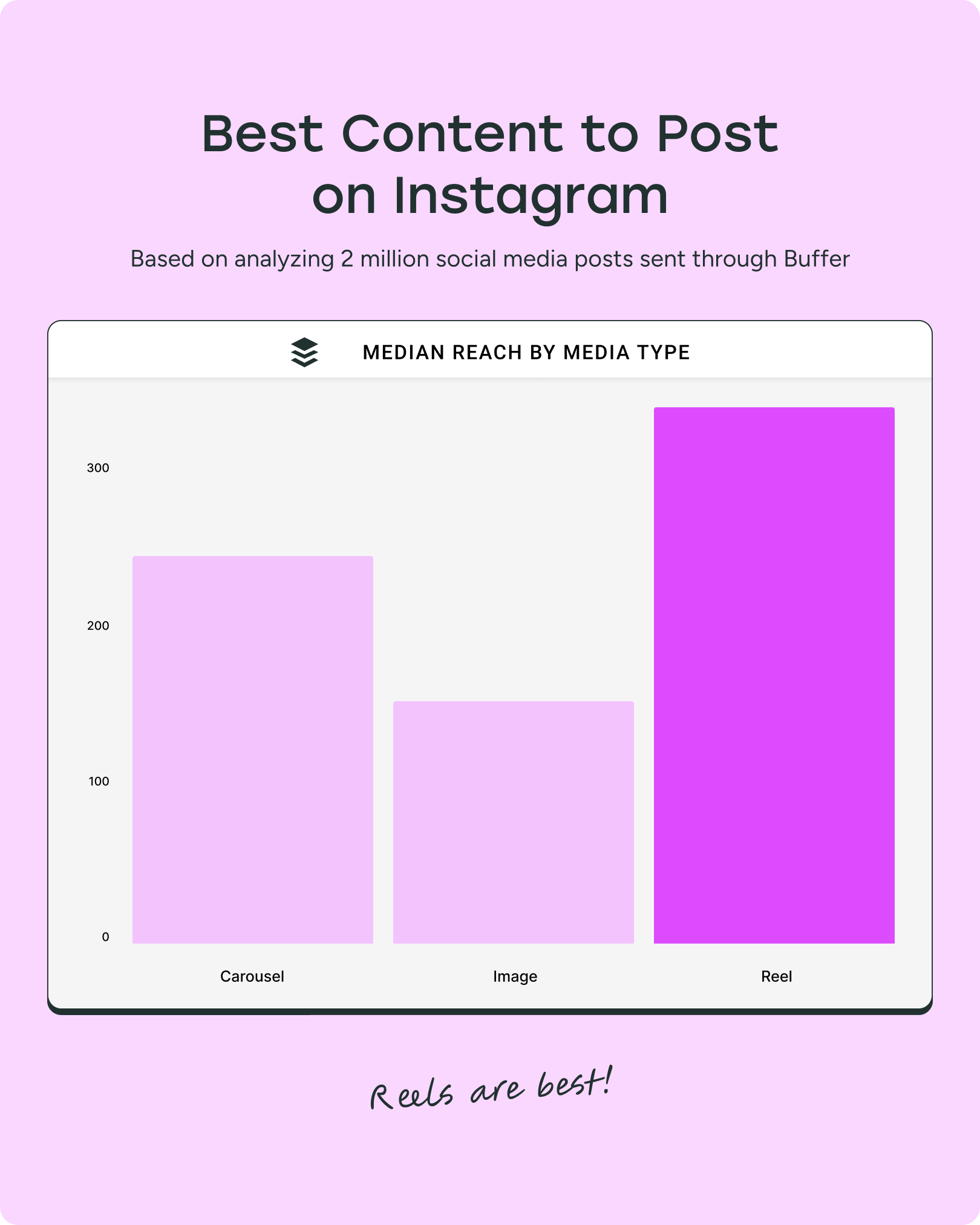
This probably won’t surprise you — the most engaging content on Instagram is video. Our data revealed that videos perform a head and shoulders above carousels and photo posts.
Reels are an excellent way to gain followers on the platform — even Instagram says so. “The most effective way to grow on Instagram is to consistently create engaging reels, as reels are the best way to reach new audiences,” head of Instagram Creator Partnerships at Meta, Carly Lynn, said in a video.
That's not to say other content types don't have an impact. Carousels tend to perform slightly better than images, though the difference is not as marked as the one between reels and everything else.
When it comes to engagement, things look a little different. Carousels tend to get more engagement than reels — so if getting more engagement is your goal, you might want to adjust your social media plan to include more of that format.
⚡️ Check out our full analysis of the performance of Instagram Reels vs. carousels vs. single-image posts here.
How to find the best time to post on Instagram for you
While all of the above posting times can be useful in helping you put together a posting schedule as you're just starting out, take it all with a pinch of salt.
There are better ways to figure out when your audience is online and engaging — and your personal best time to post on Instagram might not align with the general guidelines above.
Ultimately, there is no one-size-fits-all for the best time to post on Instagram. Your peak engagement time will likely differ from someone else's.
For example, my personal Instagram audience's activity level is pretty steady on work days and on the weekends. Their most active times are between 6 p.m. and 9 p.m.
For Buffer's Instagram following, things look a little different. They’re most active on the platform between 3 p.m. and 6 p.m.
Buffer Analytics
A social media management tool like Buffer can be really helpful in pinpointing the best times for your posts. If you're a Buffer user, our analytics offer even deeper insights into the best times to post on Instagram. To find yours:
- Head over to analyze.buffer.com in your desktop browser and make sure you're logged into your Buffer account.
- Click on Instagram on the left side of your screen. There's a host of important data to dig into here, including Instagram post performance and audience demographics.
- Click on Answers. Here, you'll find insights on a whole lot more than the best time to post on Instagram (like which post types are the best for you, or how often you should be posting) but the best time to post is the second box from the top.
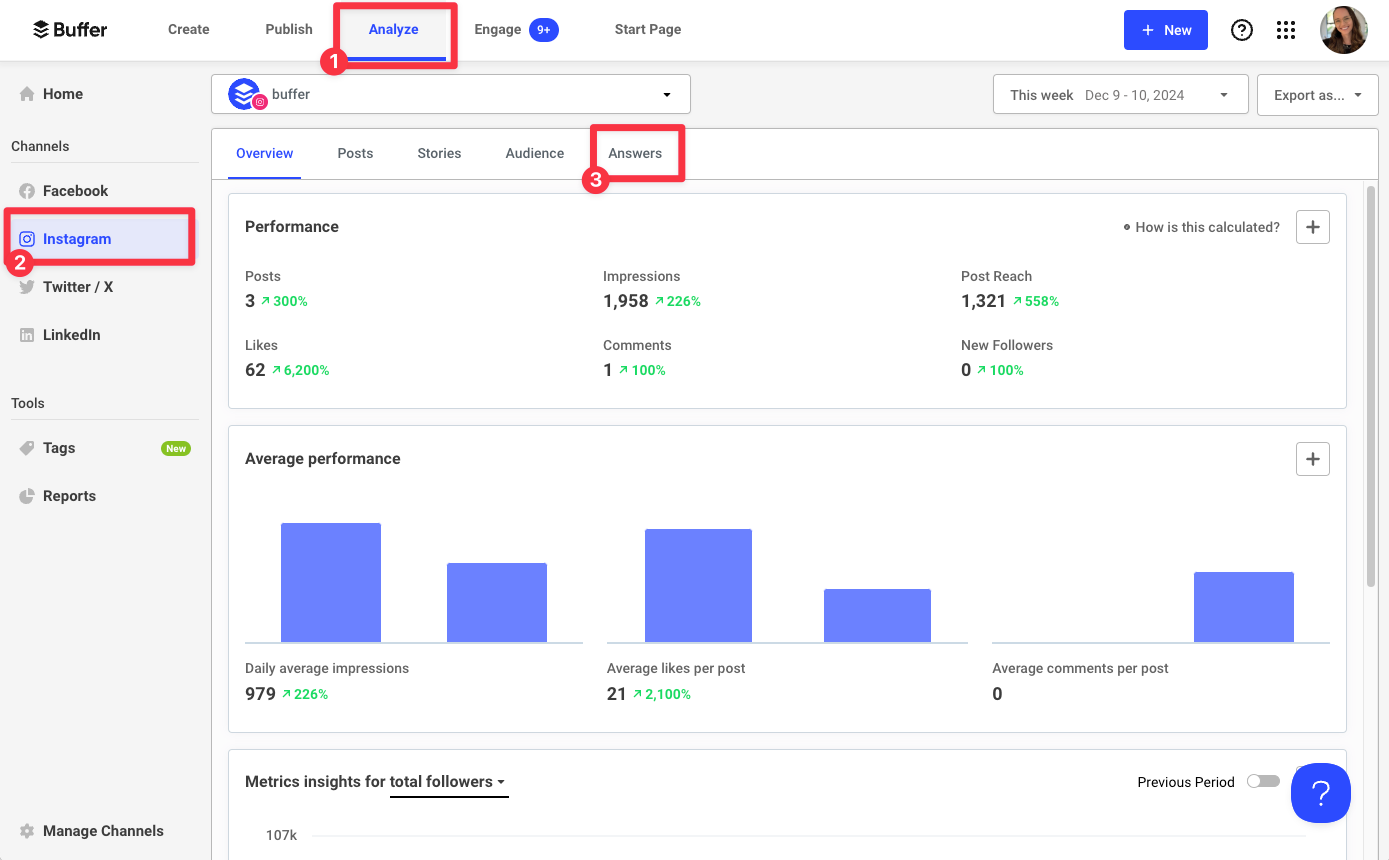
Here are some of the answers for our Instagram account in Buffer:
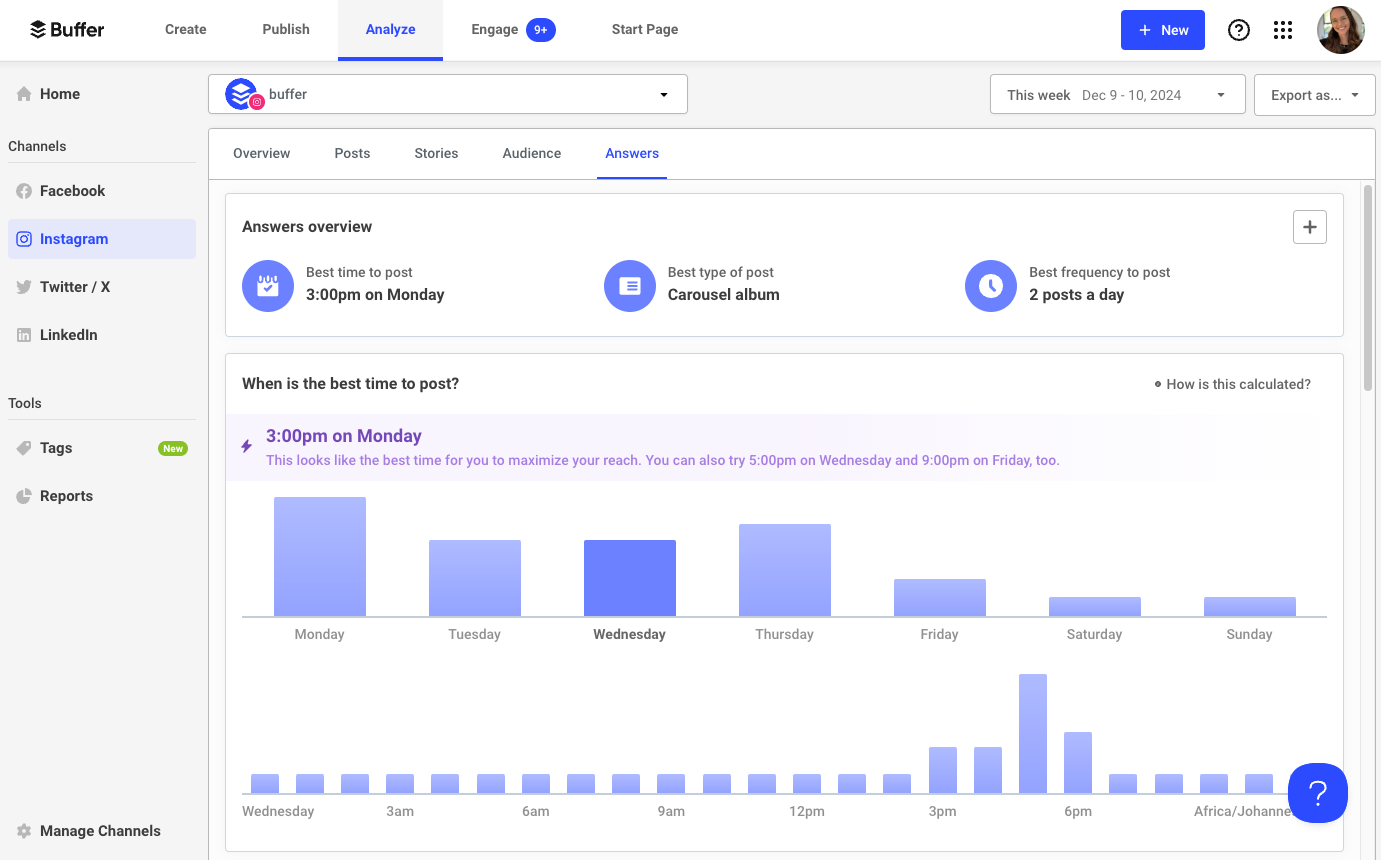
Instagram Insights
Instagram Insights, the native analytics tool for the social media platform, can be helpful in pinpointing some good times to post on Instagram.
To get stats for your own audience via the Instagram analytics baked into the app, head over to Instagram Insights on the mobile app. You’ll need to have a professional Instagram account — a Creator or Business Account — to access these numbers.
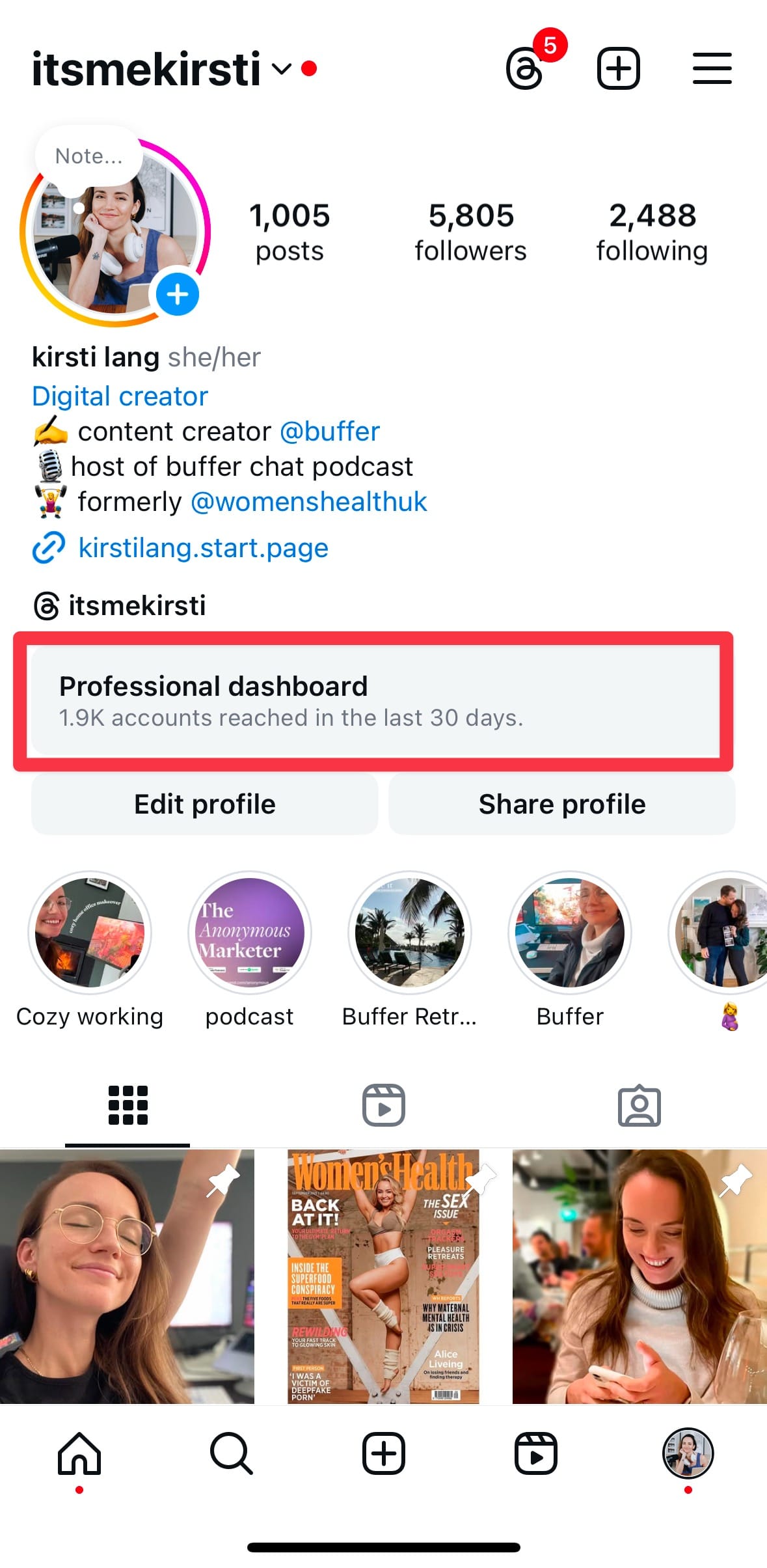
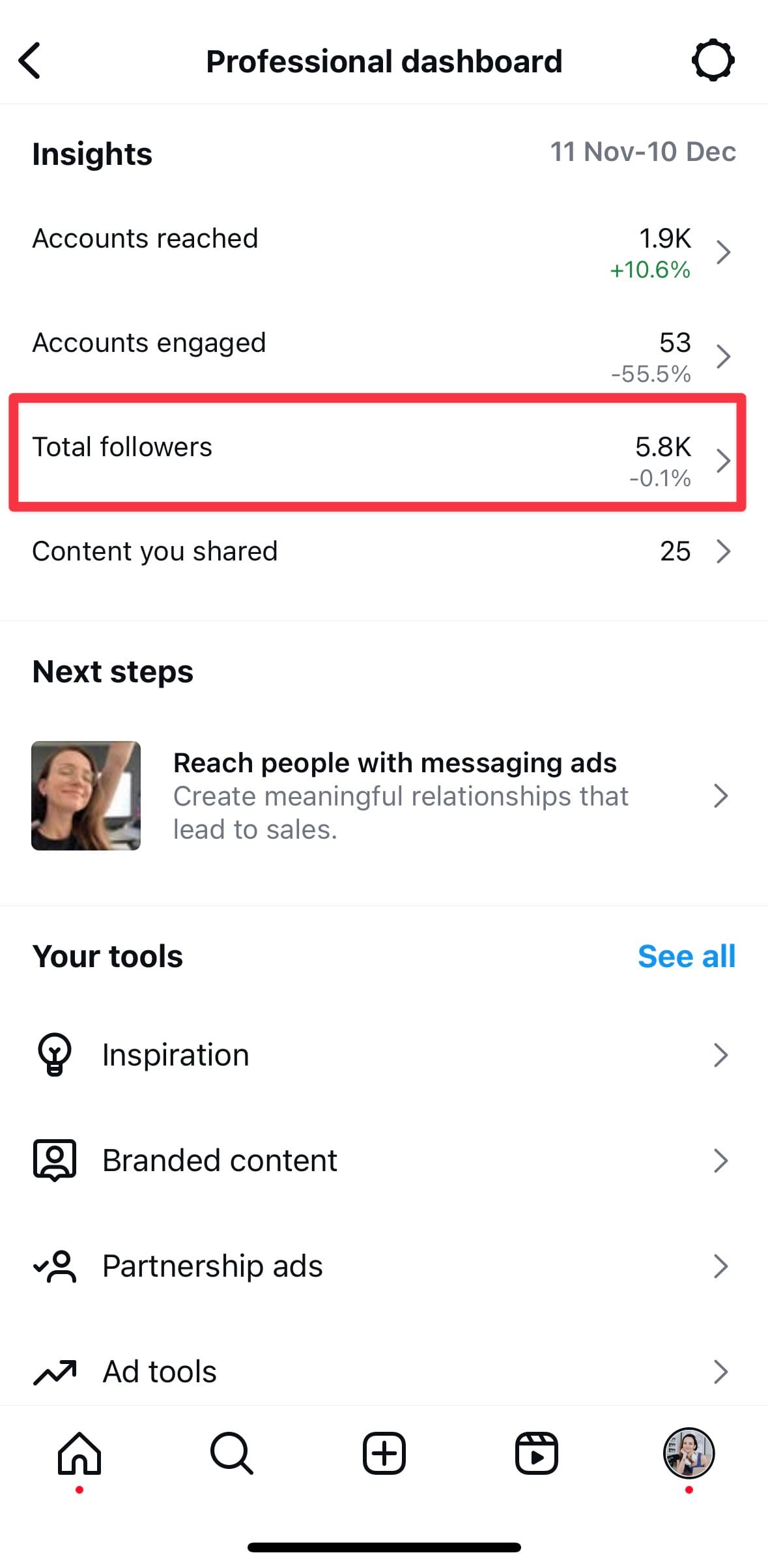
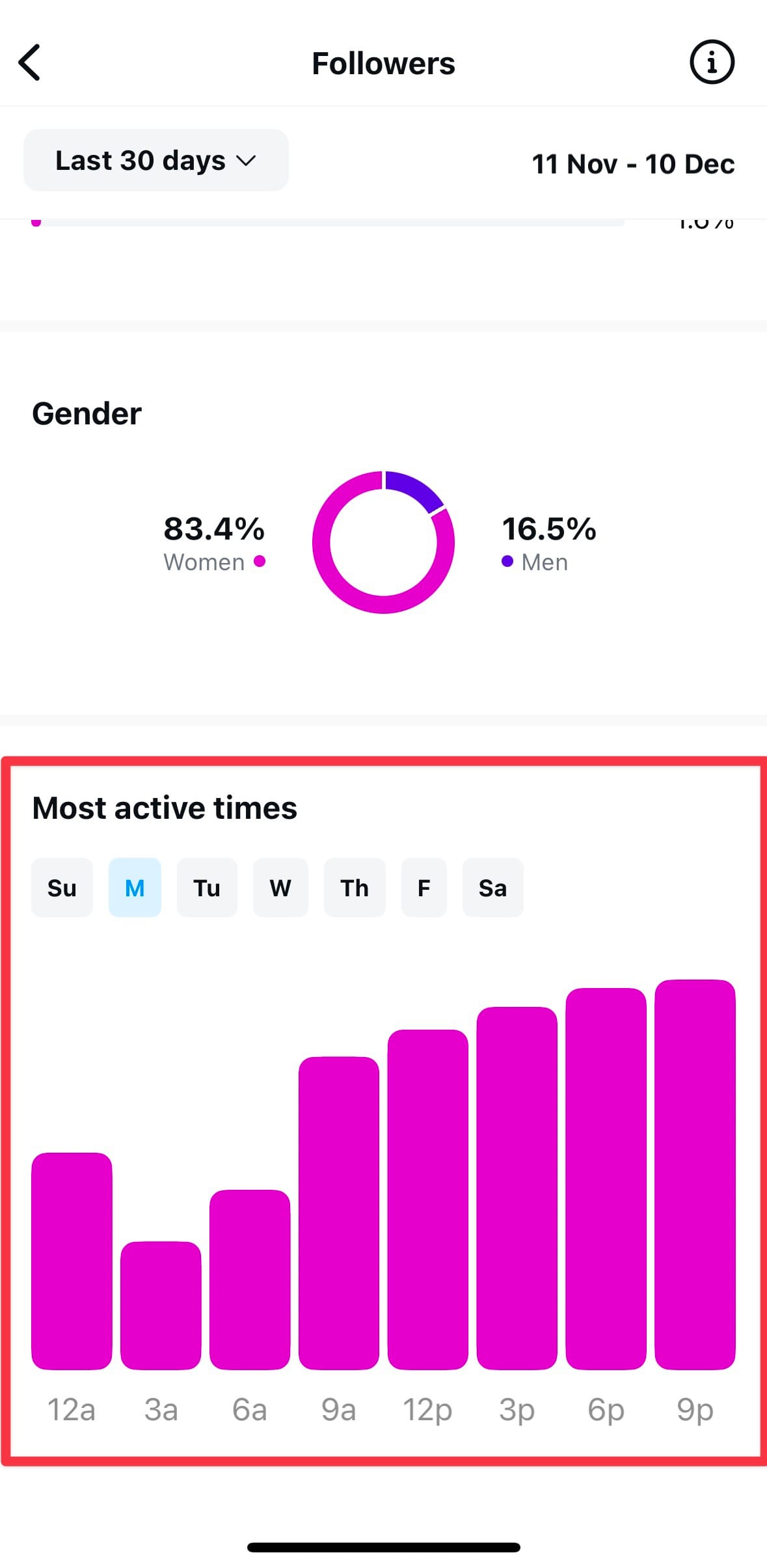
- Go to your Instagram profile and click on ‘Professional dashboard’ just below your bio.
- Tap on ’Total followers.’
- Scroll down to the bottom of this page and look for ’Most active times.’ You'll be able to toggle between every day of the week to see how they differ.
You can also access Instagram Insights via the web version of Instagram. To find yours:
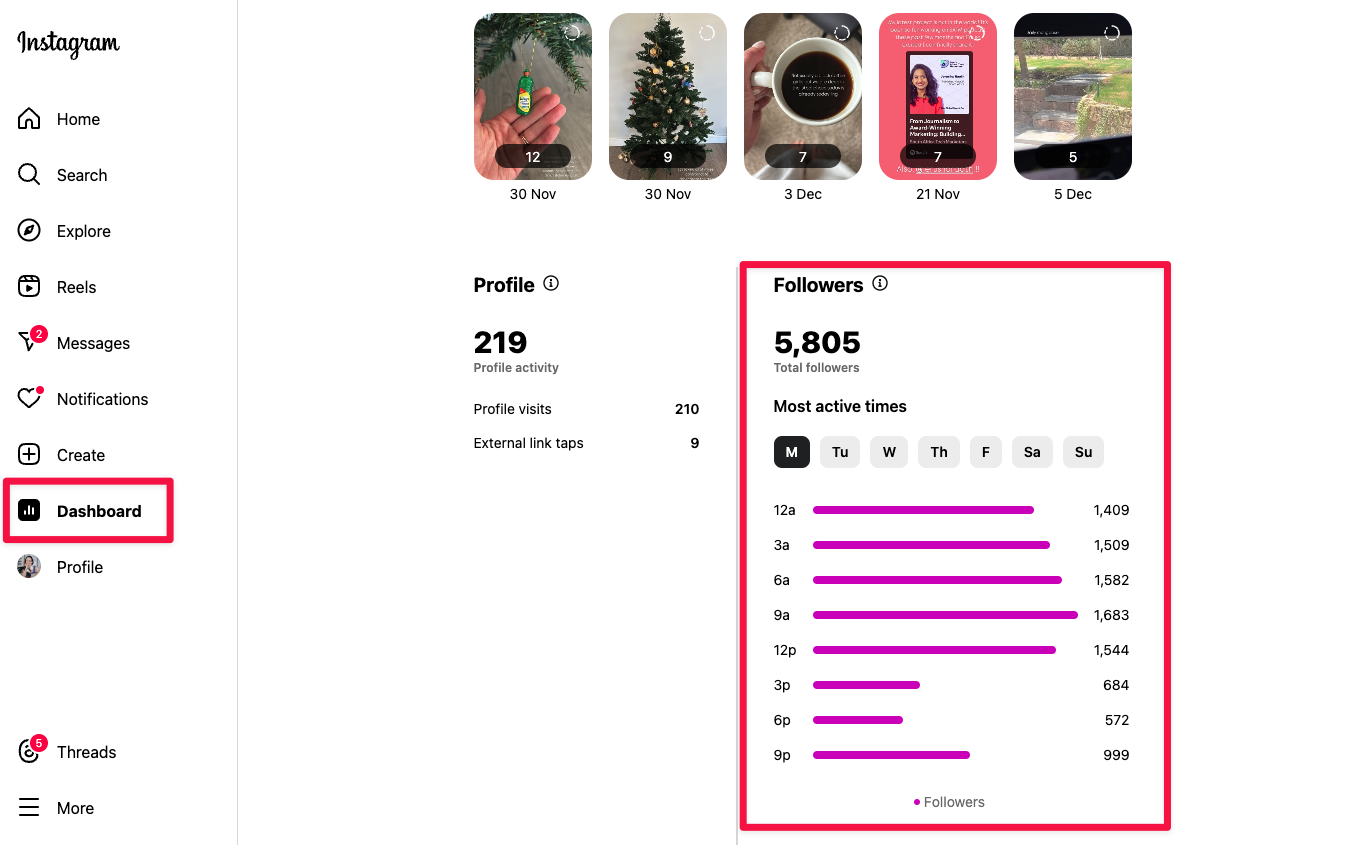
- Log into your Instagram account in your browser via instagram.com
- Click on ‘Dashboard’ on the left-hand side of the screen
- Scroll down to 'Followers' to see your audience's most active times.
If you don't see these options, you may still have a personal account — remember to switch to a creator or business account, first!
The best time to post on Instagram FAQs
Here are some commonly asked questions when it comes to the best time to schedule your Instagram posts.
Does the time you post on Instagram matter?
Our data shows that the time you post on Instagram does matter. Analyzing more than 2 million Instagram posts showed that content posted at specific times had a higher reach per followers.
That said, a high-reach posting time is not going to be enough to save a low-quality Instagram post. Sharing your Instagram Reels, photos, and stories at these optimal posting times should be the cherry on top of your Instagram strategy rather than its foundation.
For guidance on how to improve your Instagram account and content, head over to the section: Your Checklist for High-performing Instagram Posts.
When is it best not to post on Instagram?
When it comes to when not to post on Instagram, common sense rules apply. When is your target audience not online? The most obvious answer is overnight. Our analysis supports this — any Instagram posts shared between 1 a.m. and 5 a.m. tended to get the lowest reach, no matter what day of the week it is.
According to our data, Instagram posts shared on the weekends tended to have lower reach too, though there are some good times to post on Saturday and Sunday. Scroll up to The best times to post on Instagram for more.
Is it better to post early or late on Instagram?
On most weekdays, afternoons are good times to post on Instagram. Reach on posts tends to start picking up in the early morning, climbing at around midday during users' lunch breaks, and peaking at 3 p.m.
What is the best time to post on Instagram today?
As a rule of thumb, if it is a weekday, the best time to post on Instagram is usually 3 p.m. On weekends, the best time to post is 6 p.m. on both Saturday and Sunday. For more details, scroll up to the cheatsheet section above: The Best Time to Post on Instagram at a Glance.
When is the best time to post on Instagram in my country or timezone?
Many of the guides you'll find to the best times to post will be in U.S. time zones, like Eastern Time (EST) or Pacific Time (PST), which can be super confusing when it comes to figuring out your best time to post on Instagram.
But if you're based outside these zones (hello from South Africa!), all of the data above is still applicable to you. The Buffer data scientists have crunched the numbers to be universally applicable. So if the best time to post on Instagram on Friday is 3 p.m., that's 3 p.m. in your time zone — whether you're based in California or Calcutta.
How often should I post on Instagram?
Social media post frequency is important — regularly showing up on the platform is often a powerful way to gain traction. According to the Head of Instagram, Adam Mosseri, sharing one to two Instagram Stories daily and a couple of in-feed posts (reels, carousels, or photos) weekly should be enough for consistent Instagram engagement and reach.
Stories, in particular, which disappear after 24 hours, offer a helpful, lightweight way to stay consistent on the platform. Post an Instagram Story at least daily to stay top-of-mind for your followers.
I know that's not super specific, but that's because every target audience is different. Perhaps your target audience is made up of office workers who regularly check the app during their lunch breaks or students who log on late at night.
It's worth experimenting with your posting schedule to see what cadence, along with time to post, works best for your Instagram audience. Buffer can help here, too: with enough data, our analytics tools crunch the numbers for you to recommend the best posting frequency for you (and adapt as that changes). Scroll up to The best time for you to post on Instagram section to learn how.
Your checklist for high-performing Instagram posts
While figuring out the best time to post on Instagram for maximum reach is an important part of your Instagram marketing strategy, it's not the be-all and end-all.
As we unpack in our guide to the Instagram algorithm(s) there are a huge number of factors to take into account if you want your content to perform well. Here's our checklist for high-performing Instagram content:
- Make the most of Instagram's new features: As with the launch of Instagram Stories and reels, the platform loves showcasing its new features. Using them could mean getting your content in front of new audiences.
- Experiment with content types: Regularly trying out a new type of content when you post on Instagram will help you figure out what resonates the most with your audience. Plus, it's a great way to repurpose your content.
- Don't neglect your caption: According to a fascinating report by HubSpot, captions that performed the best were either very long (over 2,000 characters) or very short (less than 20). Using emojis in captions was also shown to boost Instagram engagement.
- Use hashtags: Studies show that posts with hashtags receive higher engagement than those without. Buffer's Hashtag Manager will make adding your favorite ones to your caption or comments a breeze.
- Prioritize authentic engagement: Rather than wasting time and resources on Instagram algorithm hacks, focus on fostering meaningful engagement with your followers. That means replying to comments and messages, resharing their mentions of you, and even interacting with them on their own content.
- Analyze to see what's working: Use Instagram Insights to see which of your posts have had high engagement and reach. Buffer's analytics will also help you uncover your best posts in just a few clicks.
What have you found most helpful when determining the best time to post on Instagram for you? Let us know @buffer on all our social media accounts!
Try Buffer for free
180,000+ creators, small businesses, and marketers use Buffer to grow their audiences every month.
Related Articles
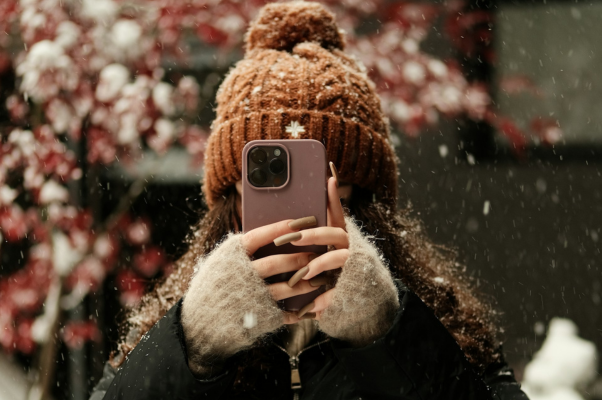
Grow your reach, celebrate your community, and keep your feed full with these reposting tips and how-tos.
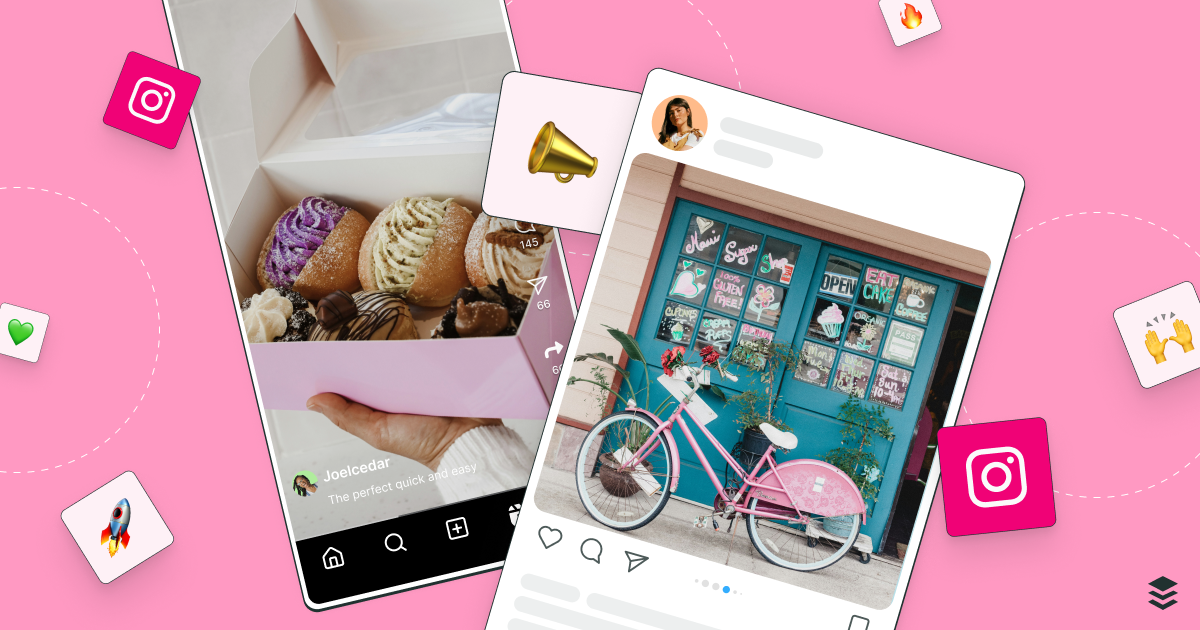
Learn the fundamentals and advanced principles of Instagram marketing — with examples, expert tips, and timely best practices.
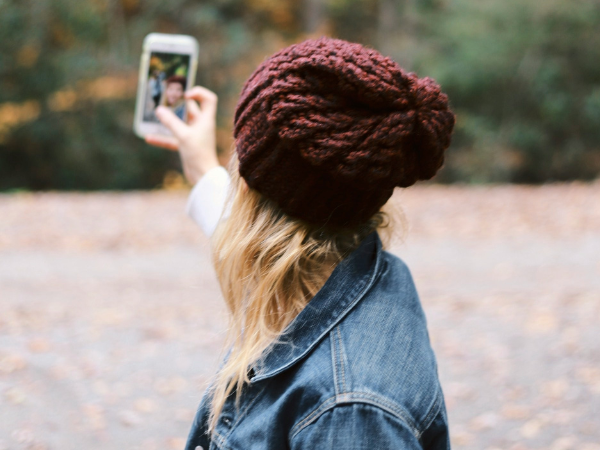
The ins and outs of Instagram Stories, from getting started to advanced strategies that will make your stories stand out on Instagram.